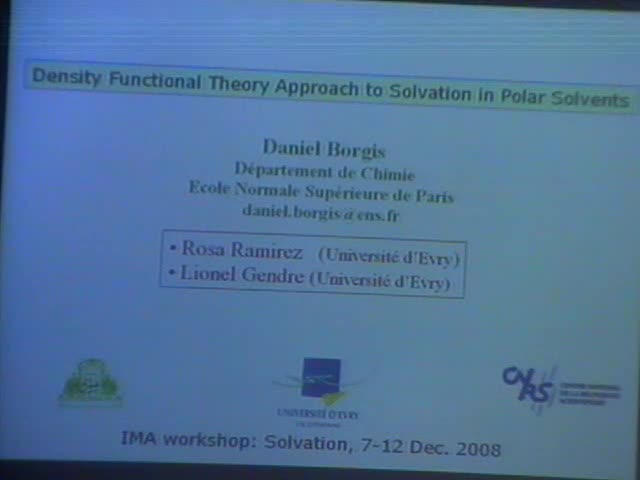Classical density functional theory approach to solvation in polar solvents
Presenter
December 12, 2008
Keywords:
- Density theorems
MSC:
- 11R45
Abstract
We draw a comparison between the quantum density functional
theory for electronic
structure calculations and the ''classical'' density
functional theory of molecular
liquids and we show how, borrowing ideas and techniques from
electronic DFT,
classical DFT can be used as a useful chemist's tool to
provide, at a microscopic
level, the solvation properties of complex molecules in polar
solvents. This
includes the determination of absolute solvation
free-energies, as well as
three-dimensional microscopic solvation structures. The
proposed strategy is
as follows: we first compute the homogeneous-fluid, position
and angle-dependent,
direct correlation function, the c-function. To this end, we
carry out extensive MD
simulations of the pure solvent, and compute this way the
position and angle-dependent
pair distribution function (the h-function). We invert
subsequently the so-called
Ornstein-Zernike equation to go from the h-function to the
c-function. This direct
correlation can then be used as the definition of the
–unknown– excess
free-energy in the expression of the free-energy functional. In
the presence of a given
molecular solute, which provides the external potential, this
functional can be minimized
with respect to the position and angle-dependent density,
using a 3D cartesian grid
for positions and a Gauss-Legendre angular grid for
orientations, to obtain, at the minimum,
the absolute solvation free-energy of the solute and the
equilibrium solvent density
profile around it. The DFT results can be compared to direct MD
simulations of the solute/solvent
system or experimental data The procedure is shown to be
efficient and accurate for
polar solvents such as acetonitrile.
[1] Rosa Ramirez, Ralph Gebauer, Michel Mareschal, and Daniel
Borgis, Phys. Rev. E, 66, 031206 (2002).
[2] Rosa Ramirez and Daniel Borgis, J. Phys. Chem B 109, 6754
(2005).
[3] Rosa Ramirez, Michel Mareschal, and Daniel Borgis, Chem.
Phys. 319, 261 (2005).
[4] Lionel Gendre, PhD Thesis, Université d'Evry, July 2008.
Manuscript in preparation.
